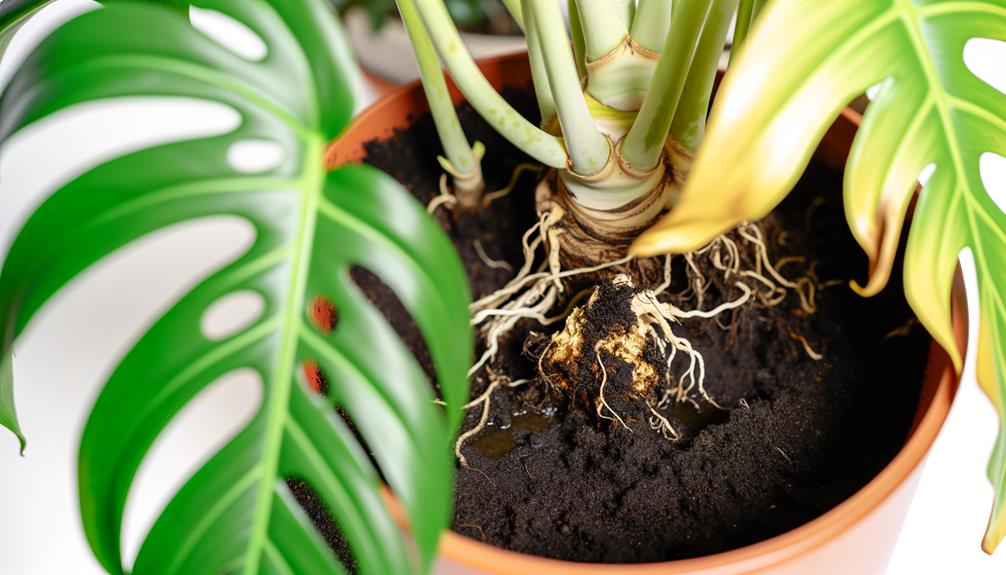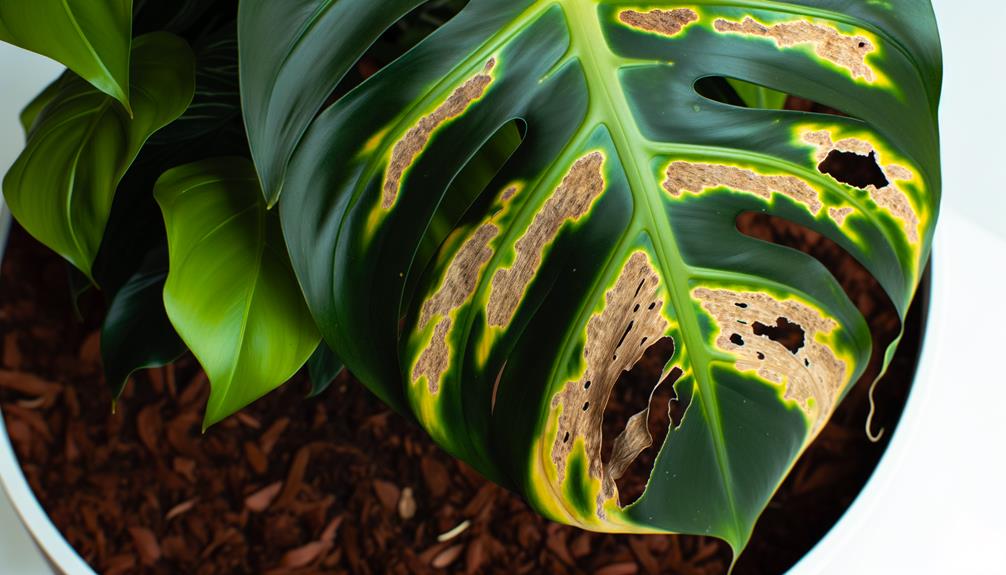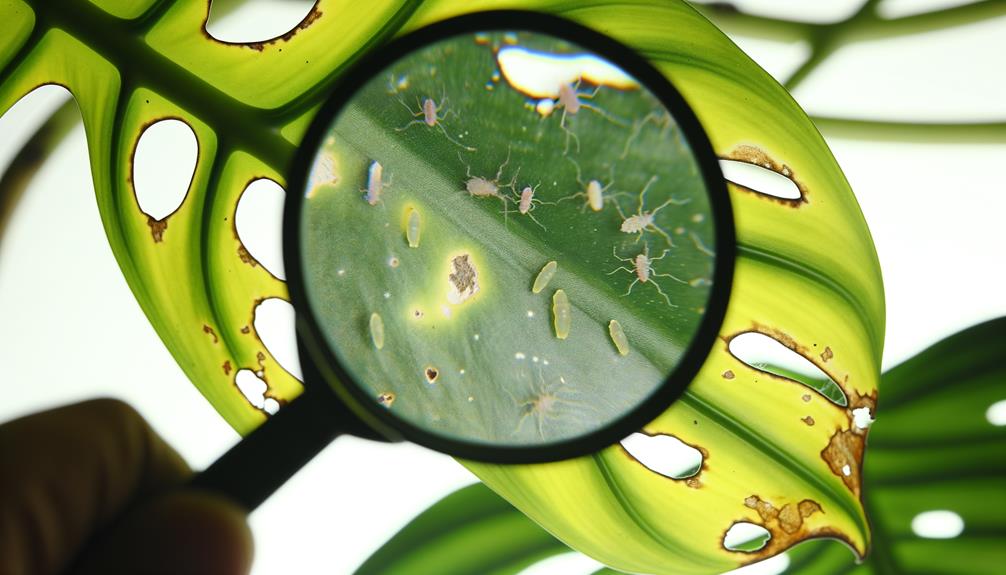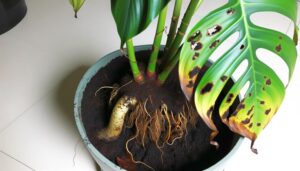What Causes Swiss Cheese Monstera to Have Yellow Leaves?
Yellow leaves on your Swiss Cheese Monstera can arise from several issues. Overwatering often leads to root rot, impairing nutrient uptake.
Insufficient light disrupts photosynthesis, causing chlorosis. Nutrient deficiencies, particularly nitrogen and iron, also result in yellowing due to disrupted chlorophyll production.
Poor soil quality affects nutrient availability and oxygen flow, further stressing the plant. Common pests like spider mites and aphids sap nutrients, causing stress.
Each factor requires specific adjustments to restore plant health. Explore further to understand the detailed corrective actions for each of these issues.

Key Takeaways
- Overwatering can lead to root rot, depriving roots of oxygen and causing yellow leaves.
- Insufficient light disrupts photosynthesis, leading to weakened plant strength and yellowing leaves.
- Nutrient deficiencies, particularly nitrogen and iron, cause chlorosis and yellow leaves.
- Pest infestations like spider mites and mealybugs extract sap, leading to chlorosis.
- High temperatures above 85°F accelerate transpiration, causing dehydration and yellowing leaves.
Overwatering Issues

Overwatering is a primary cause of yellow leaves in Swiss Cheese Monstera, leading to root rot and impaired nutrient absorption. When you water excessively, the soil becomes waterlogged, depriving roots of necessary oxygen. This anaerobic condition fosters pathogenic fungi, which attack and decompose root tissues.
Root rot, in turn, hampers the plant’s ability to uptake essential nutrients like nitrogen, phosphorus, and potassium, resulting in chlorosis, or yellowing of the leaves. To mitigate this, ensure proper drainage by using a well-aerated potting mix and containers with drainage holes. Water only when the top inch of soil feels dry.
Regularly inspecting the root system for signs of rot can prevent further deterioration and maintain peak plant health.
Insufficient Light
Beyond overwatering, another critical factor leading to yellow leaves in Swiss Cheese Monstera is insufficient light, which disrupts photosynthesis and weakens the plant’s overall strength.
When your plant doesn’t receive adequate light, its chlorophyll production diminishes, directly impacting its ability to synthesize food. Research indicates that Monstera adansonii thrives in bright, indirect sunlight, mimicking its natural habitat under the forest canopy.
By placing your plant in a dimly-lit area, you inadvertently cause chlorosis—a condition marked by yellowing leaves due to lack of chlorophyll. To rectify this, position your Monstera near a window with filtered sunlight or use grow lights.
Regularly monitor leaf color and positioning to ensure optimal light exposure, thereby maintaining a robust, healthy plant.
Nutrient Deficiencies

You’ll notice yellow leaves in your Swiss Cheese Monstera if there’s a nitrogen deficiency, characterized by older leaves turning yellow while newer leaves remain green.
Iron deficiency, on the other hand, causes younger leaves to yellow with veins remaining green, a condition known as interveinal chlorosis.
Both nutrient deficiencies disrupt chlorophyll production, leading to diminished photosynthesis and overall plant health.
Nitrogen Deficiency Symptoms
A nitrogen deficiency in Swiss Cheese Monstera typically manifests as chlorosis, where the leaves turn yellow while the veins remain green. You’ll notice that older leaves are affected first, as the plant reallocates nitrogen to new growth. This essential macronutrient is crucial for synthesizing amino acids, proteins, and chlorophyll.
When nitrogen is scarce, chlorophyll production declines, leading to reduced photosynthesis and subsequent yellowing. Test your soil to confirm nitrogen levels and consider applying a balanced fertilizer with a higher nitrogen ratio. Avoid over-fertilizing, as it can cause root burn and exacerbate the issue. Regular monitoring of soil pH helps ensure optimal nutrient uptake.
Keep an eye out for other symptoms to differentiate it from similar deficiencies.
Iron Deficiency Indicators
Iron deficiency in Swiss Cheese Monstera is characterized by interveinal chlorosis, where the leaf tissue turns yellow but the veins remain distinctly green. This symptom suggests impaired chlorophyll synthesis due to inadequate iron availability. You’ll often observe this condition first on the younger leaves, as iron is an immobile nutrient.
Conduct a soil pH test; a pH above 7 can make iron less available to plants. To correct this, you can acidify the soil using sulfur or apply chelated iron. It’s essential to ensure proper soil aeration since poor drainage can exacerbate iron deficiency.
Regularly monitor your plant’s condition and adjust care practices accordingly to maintain the best possible health and mitigate nutrient deficiencies.
Poor Soil Quality
Insufficient soil composition significantly impacts the nutrient availability for your Swiss Cheese Monstera, leading to yellowing leaves. When the soil lacks essential micronutrients or has poor drainage, the plant’s root system can’t absorb necessary nutrients effectively.
Research indicates that compacted or waterlogged soil restricts oxygen flow, causing root rot and subsequent nutrient deficiencies. Optimize the soil mix with components like peat moss, perlite, and orchid bark to enhance aeration and drainage.
Regularly test the soil pH to maintain a prime range of 5.5 to 7.0, as imbalanced pH levels can hinder nutrient uptake. By improving the soil quality, you mitigate the risk of chlorosis, thereby maintaining the overall health and vibrancy of your Monstera.
Pest Infestations

You might notice yellow leaves on your Swiss Cheese Monstera due to pest infestations. Common pests like spider mites, aphids, and scale insects can sap nutrients and cause discoloration.
Identifying these pests and implementing effective treatment methods, such as insecticidal soap or neem oil, can help restore your plant’s health.
Common Pests Identified
Pest infestations, particularly from spider mites, mealybugs, and scale insects, can cause yellowing leaves in Swiss Cheese Monstera due to their feeding habits and the subsequent stress imposed on the plant.
Spider mites, barely visible to the naked eye, extract sap from the leaves, leading to chlorosis.
Mealybugs secrete a waxy substance while feeding, creating nutrient blockages and fostering mold growth.
Scale insects latch onto stems and leaves, siphoning essential fluids and further weakening the plant.
These pests are often identified through physical inspection, looking for fine webbing, cotton-like clusters, or small, dome-shaped bumps.
Recognizing these signs early allows for timely intervention, mitigating damage and preventing the spread of infestations that could severely compromise plant health.
Effective Treatment Methods
Addressing pest infestations in Swiss Cheese Monstera requires a multifaceted approach, incorporating both chemical and organic treatment methods to effectively eradicate the pests and restore plant health. Start by identifying the exact pest type to tailor your treatment strategy.
For chemical treatments, use insecticidal soaps or systemic insecticides for severe infestations. Alternatively, organic methods like neem oil and diatomaceous earth offer eco-friendly solutions. Regularly inspect the plant and isolate it to prevent pest spread.
| Treatment Type | Method | Application Frequency |
|---|---|---|
| Chemical | Insecticidal Soap | Weekly |
| Chemical | Systemic Insecticide | Monthly |
| Organic | Neem Oil | Bi-weekly |
| Organic | Diatomaceous Earth | As needed |
| Preventative | Regular Inspection | Weekly |
Following these methods guarantees healthier foliage and mitigates yellowing leaves.
Temperature Stress
Temperature fluctuations can greatly impact the health of your Swiss Cheese Monstera, often leading to yellowing leaves as a stress response. Ideal growth occurs between 65°F and 80°F.
When exposed to temperatures below 55°F, cellular processes slow, impairing nutrient uptake and causing chlorosis. Conversely, temperatures above 85°F can accelerate transpiration, leading to dehydration and leaf discoloration.
Rapid shifts between temperature extremes exacerbate stress, disrupting the plant’s physiological balance. Research indicates that maintaining a consistent environment mitigates such stress.
Utilize a thermometer to monitor ambient conditions and adjust heating or cooling systems accordingly. By ensuring stable temperatures, you’ll reduce the risk of temperature-induced yellowing, fostering a healthier Monstera plant.
Conclusion
You’ve now got the key to diagnosing yellow leaves on your Swiss cheese monstera.
Think of each factor overwatering, insufficient light, nutrient deficiencies, poor soil quality, pest infestations, and temperature stress as pieces of a puzzle.
By methodically addressing each piece, you’ll restore your plant’s vibrant health.
In essence, it’s about creating a balanced environment where your monstera can thrive, much like fine-tuning an instrument for perfect harmony.
Apply these insights, and watch your plant flourish.






